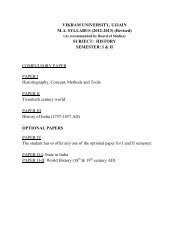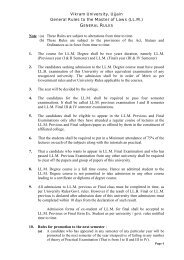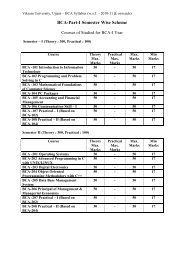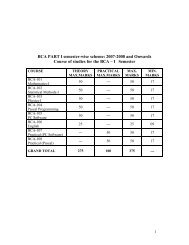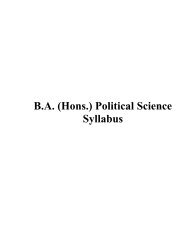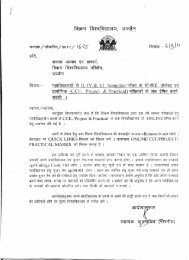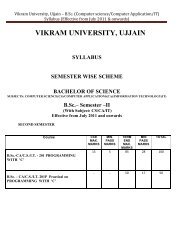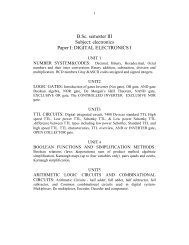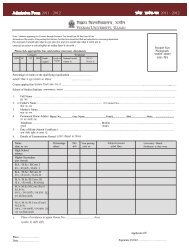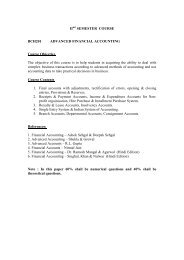SYLLABUS FOR M.PHIL/Ph.D ENTRANCE TEST
SYLLABUS FOR M.PHIL/Ph.D ENTRANCE TEST
SYLLABUS FOR M.PHIL/Ph.D ENTRANCE TEST
- No tags were found...
You also want an ePaper? Increase the reach of your titles
YUMPU automatically turns print PDFs into web optimized ePapers that Google loves.
OBJECT ORIENTED ANALYSIS AND DESIGNUNIT - 1Procedural VS OOP, Features of OOPs : Inheritance, Polymorphism, Dynamic Binding,Encapsulation.UNIT – 2OOAD (Object - Oriented Analysis and Design). Object Modelling Techniques.UNIT - 3C++ Basics ; I/O Streams, Function prototypes. Function Arguments and variable declaration.Scope Rules, Inline Functions, Qualifiers, Linkage specification and UnnamedFunction Parameters, Memory Allocation.UNIT - 4Overloading of Functions, Structures, References,Operator overloading.Classes, Constructors and destructorsUNIT - 5Inheritance : Base and Derived Classes, Single Inheritance, Multiple Inheritance, Input / OutputStreams, Templates.BOOKS :1. Rambangh : Object Modelling Techniques .
OPERATING SYSTEMS AND SYSTEM SOFTWAREUNIT -1Introduction, Early systems, Simple monitor, Buffering, Spooling, Batch processing,Multiprogramming, Time sharing. Types of operating system services. File system : Concept,Support, Access methods, Allocation methods, Directory systems, File protection.UNIT -2PROCESSOR MANAGEMENT : Introduction , Scheduling levels ; Scheduling objectives,Scheduling criteria, preemptive and non preemptive scheduling, Priorities, Deadlinescheduling , FIFO scheduling, RR, SJF, SRT scheduling , Multilevel feedback Queues.UNIT -3MEMORY MANAGEMENT :Storage Organization, Management, Hierarchy, Strategies,Fixed and variable partition Multiprogramming, Virtual Storage : Basic concepts, Paging,Segmentation, Paging/Segmentation combined Systems, Page Replacement Strategies :Locality, Working Sets, Page fault, Demand paging, LRU, FIFO, MFU, LFU, Optimal.UNIT -4DISK, DRUM SCHEDULING AND DEADLOCKS :<strong>Ph</strong>ysical Characteristics, DiskScheduling Policies ; FCFS, Shortest Seek. Time First, SCAN, Disk scheduling Algorithms,DEADLOCK : Introduction, Necessary conditions, Deadlock Prevention, Avoidance, Detection,Recovery.UNIT -5System software and application software, layered organisation of system software.Assemblers, Macros, Compilers, Cross compilers, Linking and loading, Relocation.BOOKS :1. Peterson, James, L & Silberschats, A.: Operating system concepts, Addision-Wesley, publ.comp. 1985.2. Detiel, H.M. : An Introduction to Operating system , addision wesley publ. comp. 3.Milenkovic,M. : Operating system concept and design M.H. international Edn. 1987.4. Silvestor, P.P. : The Unix system guide book, Narosa publ. house,New Delhi.5. Madnick and Donovan : Operating systems, Mcgraw-Hill book company.6. Donovan, J.J. : System programming, Mcgraw Hill,1972.7. Dhamdhere. D.M.: Introduction to system software, Tata Mcgraw Hill Publ.comp. 1986.
DATA BASE MANAGEMENT SYSTEMUNIT-1Introduction to data base system concepts : An overview of a data base system , basic data basesystem terminology.UNIT-2Entity relationship model, E.R. diagram, data independence, data definition and manipulationlanguages . an architecture for a data base system.UNIT-3Data models, relational model hierarchical model, network model.UNIT-4Storage structure, relational algebra, relational calculus, relational query language andmanipulation.UNIT-5Functional dependencies, normal forms, decomposition, integrity, protection ,security,concurrency, distributed data base.BOOKS :1. Ullman J.D. : Data base management systems2. Date C.J. : Data base management systems vol. 1.3. Korth : data base management systems.
DATA COMMUNICATION AND COMPUTER NETWORKSUNIT - 1Network goals and application, Network structure, Network services, Example of networksand Network Standardization, Networking models : centralized, distributed and collaborative.Network Topologies : Bus, Star, Ring, Tree, Hybrid : Selection and Evaluation factors.UNIT -2Theoretical Basis for Data communication, Transmission media, Twisted pair (UTP, STP),Coaxial Cable, Fiber optics : Selection and Evaluation factors. Line of Sight Transmission,Communication Satellites. Analog and digital transmission. Transmission and switching,frequency division and time division multiplexing, STDM, Circuit switching, packet switchingand message switching,UNIT - 3Brief Overview of LAN (Local Area Network) : Classification. Brief overview of Wide AreaNetwork (WAN) . Salient features and differences of LAN with emphasis on : Media, Topology,Speed of Transmission, Distance, Cost. Terminal Handling, Polling, Token passing,Contention. IEEE Standards : their need and developments.UNIT - 4Open System : What is an Open System ? Network Architectures, ISO-OSI Reference Model,Layers : Application, Presentation, Session, Transport, Network, Data Link & <strong>Ph</strong>ysical . <strong>Ph</strong>ysicalLayer - Transmission, Bandwidth, Signaling devices used, media type. Data Link Layer - :Addressing, Media Access Methods, Logical link Control, Basic algorithms/protocols.UNIT - 5Network Layer : Routing : Fewest-Hops routing, Type of Service routing, Updating Gatewayrouting information. Brief overview of Gateways, Bridges and Routers, Gateway protocols,routing daemons. OSI and TCP/IP model. TCP/IP and Ethernet. The Internet : The structure ofthe Internet, the internet layers, Internetwork problems. Internet Standards.BOOKS :1. Tannanbaum, A.S.: Computer Networks, Prentice Hall, 1985.processing, Prentice Hall,1983.2. Black : Computer Networks : Protocols, standords and Interfaces, Prentice Hall International
THEORY OF COMPILER DESIGNUNIT-1Structure of a compiler, cross compiler, finite automata and lexical analysis : The roll oflexical analyzer ,design of lexical analyzer.UNIT-2Regular expressions, finite automata, definite finite automata minimizing the no. of states of aDFA ,context free, grammers.UNIT-3Derivations and parse trees , basic parsing techniques, parses, shift -reduce parsing , operatorprecedence ,parsing, top-down parsing.UNIT-4Run-time Storage administrations, implementation of a simple stack, allocation scheme.UNIT-5Implementation of block structured languages, storage allocation in block, structued languages,code generator.BOOKS :1 Aho, ullman : Principles of compiler design.
INTERNETWORK APPLICATIONUNIT - 1 ( TCP/IP )TCP/IP Model : Comparison with ISO -OSI reference model. TCP/IP Protocol Family :Transport : Transmission Control Protocol, TCP Header Format, UDP Routing : IP Addressing, limitations , Brief overview of IPV6 i.e. the next generation IP, IP header format. NetworkAddresses : ARP, Domain Name System (DNS), RARP.UNIT-2User Services /Applications : File Transfer Protocol (FTP) : Channel Connection, Command :internal & Users, Connections, debugging option with FTP, third party transfer, anonymous FTP,FTP Servers, TFTP, Telnet, BOOTP, Gateway Protocols : brief overview of EGP, CGP &IGP, Other protocols : NFS, NIS, RPC, SMTP, SNMP.UNIT - 3. ( Internet and Intranet )Internet : Uses, Goals/advantages, WWW, Intranet : Goals, benefits, how TCP/IP, bridges,routers, E-mail works in an intranet, Intranet and WWW : IP Networks, HTTP, Commands,Intranet applications : Overview of Web-Servers : essential & desirable features of a web server: authentication , authorization and encryption ; proxy services ; Subnetting an intranet.UNIT-4 : ( WAN, E-mail )Overview of an intranet security system : Security and access policies, Server Security,Firewalls, General Security. WAN : overview of DDS, T-1, T-3 , Frame Relay, Sonet, SMDS,ATM Services, WAN implementation, Connecting the LANs : Bridges, routers, AccessingWAN, Message handling system : X.400 & X.500 , Message Transfer Agents (MTA),Mailbox.UNIT-5 ( The Socket Programming Interface )Development of the Socket Programming Interface : Socket Services, Creating a Socket ,Binding the Socket , Connecting to the Destination , open Command , Sending Data , ReceivingData , Server Listening , Closing a Connection , Aborting a Connection , UNIX Forks.Network services - file servers, message servers , Directory servers, print servers,application servers.Books:Douglas J. Comer : Internetworking with TCP/IP (Vol I)Richard Stevens : Unix Networkin
NETWORK SECURITYUnit -1Conventional EncryptionConvention Encryption : Conventional Encryption Model , Steganography , Classical EncryptionTechniques, Simplified DES , Block Cipher Principles , The Data Encryption Standard, The Strengthof DES , Differential and Linear Cryptanalysis, Block Cipher Design Principles, Block CipherModes of operation, ConventionalUnit -2Encryption algorithms: Public Key Encryption And Hash Functions Public Key Cryptography, Principles of Public Key Cryptosystems , The RSA Algorithm , Key Management , DiffieHellman Key Exchange , Elliptic Curve Cryptography.Unit -3Message Authentication and Hash Functions Authentication Requirements, AuthenticationFunctions, Message Authentication Codes , Hash Functions , Security of Hash FunctionsUnit -4Hash And Mac Algorithms MD5 Message Digest Algorithm , Secure Hash Algorithm (SHA-I), RIPEMD ,HMACUnit -5Digital Signatures and Authentication Protocols Digital Signatures , Authentication Protocols-Digital Signature Standard Authentication Applications , IP Security , Web SecurityIntruders, Viruses and Worms Intruders , Viruses and Related Threats Firewalls FirewallDesign Principles , Trusted SystemsReference Books :1. William Stallings, “ Cryptography and Network Security”, Second edition,Prentice Hall, 1999.2. Atul Kahate, “ Cryptography and Network Security,” TMH3. William Stallings,"Cryptography and Network Security",Third Edition, PearsonEd4. Introduction to network security, Krawetz, Cengage



